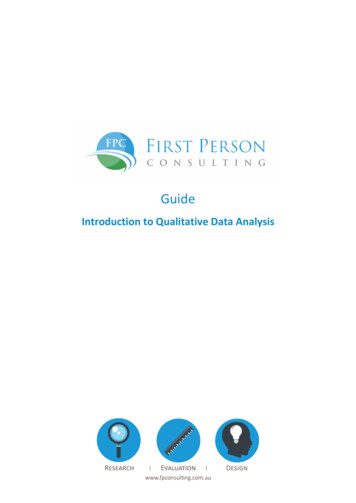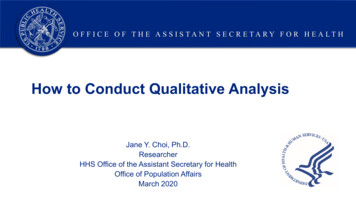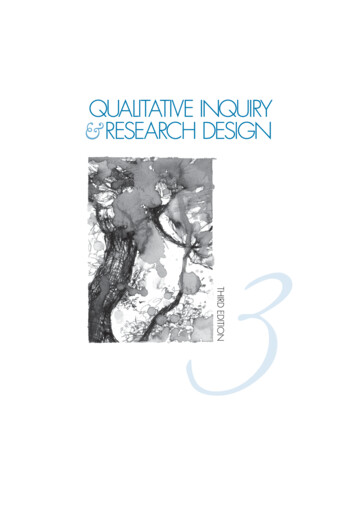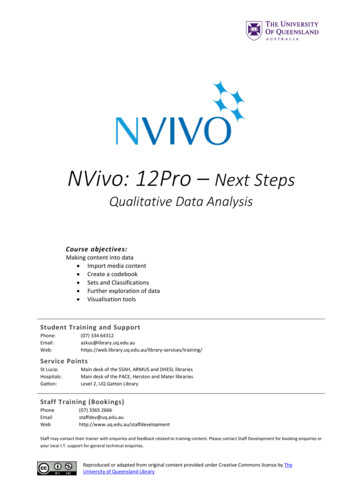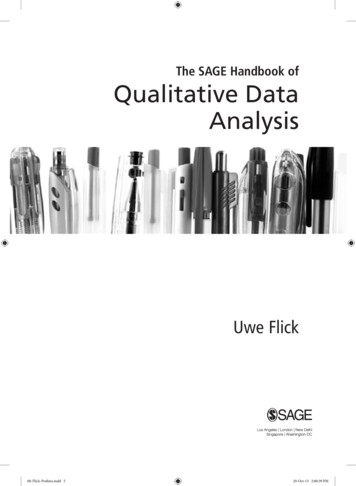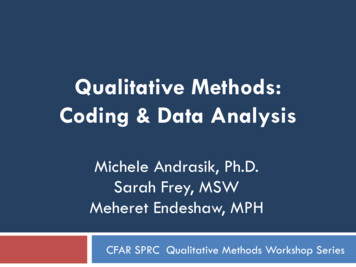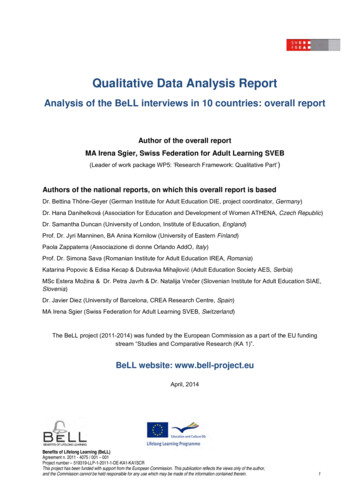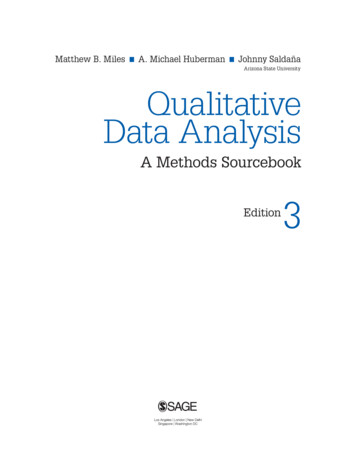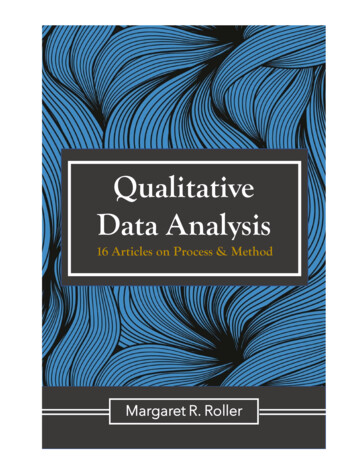
Transcription
QualitativeData Analysis16 Articles on Process & MethodMargaret R. Roller
The contents of this compilation include a selection of 16 articles appearing inResearch Design Review from 2010 to December 2019 concerning qualitative data analysis.Excerpts and links may be used, provided that the proper citation is given.Table of ContentsTotal Quality FrameworkAnalyzable Qualitative Research: The Total Quality Framework Analyzability Component1Finding Connections & Making Sense of Qualitative Data4ProcessThe Messy Inconvenience of Qualitative Analysis6Chaos & Problem Solving in Qualitative Analysis8Words Versus Meanings10Qualitative Data Processing: Minding the Knowledge Gaps13Qualitative Data Analysis: The Unit of Analysis15The Qualitative Analysis Trap (or, Coding Until Blue in the Face)17The Important Role of “Buckets” in Qualitative Data Analysis19Data FormatsThe Limitations of Transcripts: It is Time to Talk About the Elephant in the RoomThe Virtue of Recordings in Qualitative Analysis2123VerificationVerification: Looking Beyond the Data in Qualitative Data AnalysisManaging Ghosts & the Case for Triangulation in Qualitative Research2527Qualitative Content Analysis MethodA Quality Approach to Qualitative Content Analysis29Secondary & Primary Qualitative Content Analysis: Distinguishing Between the Two Methods32Qualitative Content Analysis: The Challenge of Inference35Qualitative Data Analysis May 2020@Margaret R. Roller
Analyzable Qualitative Research:The Total Quality FrameworkAnalyzability ComponentA March 2017 article in Research Design Review discussed the Credibilitycomponent of the TotalQuality Framework(TQF). As stated in theMarch article, the TQF“offers qualitativeresearchers a way to thinkabout the quality of theirresearch designs acrossqualitative methods andirrespective of anyparticular paradigm ortheoretical orientation”and revolves around thefour phases of the qualitative research process – data collection, analysis,reporting, and doing something of value with the outcomes (i.e., usefulness). TheCredibility piece of the TQF has to do with data collection. The main elements ofCredibility are Scope and Data Gathering – i.e., how well the study is inclusive ofthe population of interest (Scope) and how well the data collected accuratelyrepresent the constructs the study set out to investigate (Data Gathering).The present article briefly describes the second TQF component – Analyzability.Analyzability is concerned with the “completeness and accuracy of the analysisand interpretations” of the qualitative data derived in data collection and consistsof two key parts – Processing and Verification. Processing involves the carefulconsideration of: (a) how the preliminary data are transformed into the final datasetthat is used in analysis and (b) the actual analysis of the final set of data. Thetransformation of preliminary data typically involves converting audio or videorecordings to a written transcript. From a TQF perspective, the qualitativeresearcher needs to give serious thought to, among other things, the quality of thetranscripts created, with particular attention to the knowledge and accuracy of thetranscriptionist*. The qualitative researcher also needs to reflect on the limitationsof transcripts and, specifically, what can and cannot be learned from the data intranscript form.1Qualitative Data Analysis May 2020@Margaret R. Roller
Once the final dataset has been developed, the qualitative researcher is ready tomake sense of the data by way of analysis. The analysis process may vary amongresearchers depending on their particular approach or orientation. Broadlyspeaking, the analysis involves: (a) selecting the unit of analysis (e.g., an entire indepth interview), (b) developing codes (designations that give meaning to someportion of the data in the context of the interview and research question), (c)coding, (d) identifying categories (i.e., groups of codes that share an underlyingconstruct), (e) identifying themes or patterns across categories, and (f) drawinginterpretations and implications.Verification is the other principal piece of the TQF Analyzability component. It isat the Verification stage – that is, when interpretations and implications are beingconceptualized – that qualitative researchers give critical attention to the data bylooking for alternative sources of evidence that support or contradict earlyinterpretations of the study data. The verification step is an important one thatcontributes heavily to the overall quality of a qualitative research design. Thevarious verification techniques include: (a) peer debriefing (the unbiased review ofthe research by an impartial peer), (b) a reflexive journal (the researcher’s diary ofwhat went on in the study including reflections on their own values or beliefs thatmay have impacted data gathering or analysis), (c) triangulation (contrasting andcomparing the data with other sources, such as data from different types ofparticipants, different methods, or different interviewers or moderators), and (d)deviant cases (looking for “negative cases” or outliers that contradict the prevailinginterpretation). There is another verification technique – member checking – thatmany researchers endorse but, from a TQF perspective, potentially weakens thequality of a qualitative study**.Verification is the topic of discussion in a 2014 article posted in RDR –“Verification: Looking Beyond the Data in Qualitative Data Analysis.” Readers ofthis blog will also be interested in the Morse, et al. (2002) article in InternationalJournal of Qualitative Methods on verification strategies where the authorsadvocate utilizing verification “mechanisms” during the course of the qualitativeresearch per se (i.e., not just at the analysis stage) to ensure the “reliability andvalidity and, thus, the rigor of a study.”Not unlike credible qualitative research (the subject of the March RDR post),analyzable qualitative research is the product of knowing how to think aboutquality approaches to data processing and verification. It is not about concreteprocedures to follow but rather the ability to conceptualize and integrate researchpractices that maximize the validity as well as the ultimate usefulness of aqualitative research study. The TQF Analyzability component is a vehicle bywhich qualitative researchers can think about where and how to apply quality2Qualitative Data Analysis May 2020@Margaret R. Roller
principles in the processing and verification of their data. In doing so, researchersgain rich interpretations of the data leading to outcomes that address the researchquestion and have value.Value or usefulness, however, is not solely dependent on credible and analyzableresearch. Before a qualitative study can be truly useful it must be effectivelycommunicated. That is where Transparency – the third component of the TQF andthe subject of the next blog post – comes in.*Specific recommended qualities of a transcriptionist are delineated in Roller & Lavrakas (2015, p. 35).**A discussion of member checking and its potential to weaken study design can be found in Roller & Lavrakas(2015, p.43).Morse, J. M., Barrett, M., Mayan, M., Olson, K., & Spiers, J. (2002). Verification strategies for establishingreliability and validity in qualitative research. International Journal of Qualitative Methods, 1(2), 13–22.Roller, M. R., & Lavrakas, P. J. (2015). Applied qualitative research design: A total quality framework approach.New York: Guilford Press.3Qualitative Data Analysis May 2020@Margaret R. Roller
Finding Connections & Making Sense ofQualitative DataThe analysis of qualitative research data is no small thing. Because the very natureof qualitative research is complicated bythe complexities inherent in beinghuman, attempting to qualitativelymeasure and then make sense ofbehavior and attitudes is daunting. Infact, it is this overwhelming aspect ofqualitative research that may leadresearchers – who live in the real worldof time and budget constraints – tosuccumb to a less-than-rigorousanalytical process.And yet, Analyzability* is a critical component in qualitative research design.All of the data collection in the world – all the group discussions, IDIs,observations, storytelling, or in-the-moment research – amounts to a meaninglessexercise unless and until a thorough processing and verification of the data isconducted. Without the thoughtful work required to achieve a quality researchproduct, qualitative data simply sits as an inert compilation of discrete elementslacking import.Finding the connections in the qualitative data that make sense of the phenomenon,concept, or construct under investigation may, for some, be difficult and worthy ofshortcuts; but proper analysis is the only thing that separates an honest,professional qualitative study from a random amalgamation of conversations oronline snapshots.In April of 2014, Research Design Review discussed one facet of Analyzability,i.e., verification. Verification, however, only comes into play after the researcherhas conducted the all-important processing phase that converts qualitative data –that amalgamation of discrete elements – into meaningful connections that giverise to interpretations and implications, and the ultimate usefulness, of the research.A quality approach to qualitative research design necessitates a well-thought-outplan for finding connections and making sense of the data. Here are sixrecommended steps in that process*:4Qualitative Data Analysis May 2020@Margaret R. Roller
Select the unit of analysis – a subject matter, an activity, a completenarrative or interview. Develop unique codes – an iterative process utilizing a codebook that paysparticular attention to context to derive explicit, closely-defined codedesignations. Code – a dynamic process that incorporates pretesting of codes, inter-coderchecks, and coder retraining as necessary. Identify categories – a group of codes that share an underlying construct. Identify themes or patterns – by looking at the coding overall and theidentified categories to reveal the essence of the outcomes. This may bemade easier by way of visual displays via various programs such asPowerPoint and CAQDAS**. Draw interpretations and implications – from scrutinizing the coded andcategorized data as well as ancillary materials such as reflexive journals,coders’ coding forms (with their comments), and other supportingdocuments.* Analyzability is one of four components of the Total Quality Framework. This framework and the six generalsteps in qualitative research analysis are discussed fully in Applied Qualitative Research Design: A Total QualityFramework Approach (Roller, M. R. & Lavrakas, P. J., 2015).** Computer-assisted qualitative data analysis software, such as NVivo, Atlas.ti, MAXQDA and othersImage captured from: ement.php/5Qualitative Data Analysis May 2020@Margaret R. Roller
The Messy Inconvenience of Qualitative AnalysisQualitative analysis is difficult. We can wish that it wasn’t so but the fact remainsthat the nature of qualitative research, by definition, makes analysis prettymessy. Unlike the structured borders we buildinto our quantitative designs that facilitate anorderly analytical process, qualitative researchis built on the belief that there are real peoplebeyond those quantitative borders and that richlearning comes from meaningfulconversations.But the course of a meaningful conversation isnot a straight line. The course of conversationis not typically one complete coherent streamof thought followed by an equally wellthought-out rejoinder. These conversations arenot rehearsed to ensure consistent, logical feedback to our research questions; butinstead are spontaneous discussions where both interviewee and interviewer arethinking out loud, continually modifying points of view or ideas as human beingsdo.The messiness of the interconnections, inconsistencies, and seemingly illogicalinput we reap in qualitative research demands that we embrace the tangles of ourconversations by conducting analyses close to the source. While this means hoursanalyzing audio and/or video recordings, it is what is necessary. It is what wesigned up for.I am reminded almost daily of the challenge qualitative researchers face inanalysis. I see this challenge when I read an article such as this one in Quirk’sdevoted to “a structured approach” to qualitative analysis; when a Twitter feedduring The Market Research Event alerts me to several speakers espousing “better,faster, cheaper” qualitative research; and from my own studies which have latelyinvolved turning over reams of written transcripts that have been misused andmisconstrued by clients who cherry-pick the content.So qualitative analysis is hard. We can use all the technology in the world tocapture specific words and sentiment but we cannot make qualitative analysissomething that it is not. As Maher et al. (2018) acknowledge, computer coding ofqualitative outcomes has its place (e.g., in data management) yet it sidelines theall-important role of the human interaction that takes place in a qualitative researchenvironment.6Qualitative Data Analysis May 2020@Margaret R. Roller
As in everything we do, researchers want to understand howpeople think. And our analytical efforts should acknowledgethat people do not think in a straight line. Maybe it would beuseful to take a lesson from Mark Gungor and imagine thatour research participants are women whose brains consist ofa “big ball of wire” where everything is connected toeverything else, in contrast to men whose brains are “madeup of little boxes” that are isolated and don’ttouch. Wouldn’t it be nice if analysis was just about opening up a self-containedbox, extracting neat thoughts, and moving on to the next box?Maher, C., Hadfield, M., Hutchings, M., & de Eyto, A. (2018). Ensuring Rigor in Qualitative Data Analysis: ADesign Research Approach to Coding Combining NVivo With Traditional Material Methods. International Journalof Qualitative Methods, 17(1), 1–13. https://doi.org/10.1177/1609406918786362Image captured from: http://www.kwetech.com/index.php?section Services&subs Wire%20Harness&page Wire%20Harness.html7Qualitative Data Analysis May 2020@Margaret R. Roller
Chaos & Problem Solving in Qualitative AnalysisIn Conceptual Blockbusting: A Guide to Better Ideas, James Adams offers readers avaried and ingenious collection of approaches to overcoming the barriers to effectiveproblem solving. Specifically,Adams emphasizes the idea that tosolve complex problems, it isnecessary to identify the barriers andthen learn to think differently. As faras barriers, he discusses four“blocks” that interfere withconceptual thinking – perceptual,emotional, cultural andenvironmental, and intellectual andexpressive – as well as ways tomodify thinking to overcome theseblocks – e.g., a questioning attitude, looking for the core problem, list-making, andsoliciting ideas from other people.Adams’ chapter on emotional blocks discusses ways that the thinking processbuilds barriers to problem solving. One of these is the inability or unwillingness tothink through “chaotic situations.” Adams contends that a path to complexproblem solving is bringing order to chaos yet some people have “an excessivefondness for order in all things” leaving them with an “inability to tolerateambiguity.” In other words, they have “no appetite for chaos.” Adams puts it thisway –The solution of a complex problem is a messy process. Rigorous and logicaltechniques are often necessary, but not sufficient. You must usually wallow inmisleading and ill-fitting data, hazy and difficult-to-test concepts, opinions, values,and other such untidy quantities. In a sense, problem-solving is bringing order tochaos. (p. 48)Problem solving is a “messy process” and no less so when carrying out an analysisof qualitative data. There are several articles in Research Design Review thattouch on the messiness of qualitative analysis. In particular, “The MessyInconvenience of Qualitative Analysis” underscores the idea that8Qualitative Data Analysis May 2020@Margaret R. Roller
Unlike the structured borders we build into our quantitative designs that facilitatean orderly analytical process, qualitative research is built on the belief that thereare real people beyond [these borders] and that rich learning comes frommeaningful conversations. But the course of a meaningful conversation is not astraight line. The course of conversation is not typically one complete coherentstream of thought followed by an equally well-thought-out rejoinder.Put differently, qualitative analysts must endure a certain amount of chaos if theyare to achieve their goal of bringing some semblance of “order” (i.e.,interpretation) to their in-depth interview, focus group, ethnographic, narrative, orcase study data. It is their ability to embrace the tangled web of human thoughtand interaction that allows qualitative researchers to unravel the most complexproblem of all – how people think or do the things they do.It may also be the reason why qualitative analysis remains such a mystery toquantitative-leaning researchers and, indeed, the impediment that discourages theseresearchers from using qualitative methods, either alone or in mixed-methoddesigns. Qualitative analysis requires a conscious effort to accept some chaos, tonot rush the march to find order in the data, and to feel comfortable in the notionthat this process will lead to meaningful outcomes.Although bringing some measure of order is a necessary ingredient to the analysisprocess, “the ability to tolerate chaos,” as Adams states, “is a must.” In thisrespect, Adams talks about the “limited problem-solver” as one who struggles withThe process of bringing widely disparate thoughts together [and who] cannot worktoo well because [his] mind is not going to allow widely disparate thoughts tocoexist long enough to combine [them into a meaningful solution]. (p. 48)Qualitative analysis is not unlike solving complex problems that demand problemsolvers who are not limited by the need for order but rather embrace the morechaotic and richer world of humans’ lived experiences.Image captured from: 7019Qualitative Data Analysis May 2020@Margaret R. Roller
Words Versus MeaningsThere is a significant hurdle that researchers facewhen considering the addition of qualitativemethods to their research designs. This has to dowith the analysis – making sense – of thequalitative data. One could argue that there arecertainly other hurdles that lie ahead, such asthose related to a quality approach to datacollection, but the greatest perceived obstacleseems to reside in how to efficiently analyzequalitative outcomes. This means thatresearchers working in large organizations thathope to conduct many qualitative studies over thecourse of a year are looking for a relatively fastand inexpensive analysis solution compared tothe traditionally more laborious thought-intensiveefforts utilized by qualitative researchers.Among these researchers, efficiency is defined interms of speed and cost. And for these reasonsthey gravitate to text analytic programs and models powered by underlyingalgorithms. The core of modeling solutions – such as word2vec and topicmodeling – rests on “training” text corpora to produce vectors or clusters of cooccurring words or topics. There are any number of programs that support thesetypes of analytics, including those that incorporate data visualization functions thatenable the researcher to see how words or topics congregate (or not), producingimages such as phi/10Qualitative Data Analysis May 2020@Margaret R. Roller
9de6#.pcne7qf0zWords are important. Words are how we communicate and convey ourthoughts. And the relationships between words and within phrases can be usefulindicators of the topics and ideas we hope to communicate. Words, on the otherhand, do not necessarily express meaning because it is how we use the words wechoose that often defines them. How we use our words provides the context thatshapes what the receiver hears and the perceptions others associate with ourwords. Context pertains to apparent as well as unapparent influences that take themeaning of our words beyond their proximity to other words, their use inrecognized terms or phrases, or their imputed relationship to words from GoogleNews (word2vec).For example, by the words alone and without a contextual reference, it would bedifficult to understand the meaning of the following comment made by a malefocus group participant:“A woman’s place is in the home.”Was this participant making a comment on traditional values, or was he expressingintolerance on a broader scale, or was he emphasizing the importance of home andhome life?Context is also provided by the manner in which the words are spoken. Aneducator participating in an in-depth interview, for example, might state,“I use technology in the classroom when I can!”11Qualitative Data Analysis May 2020@Margaret R. Roller
While another educator might state,“I use technology in the classroom, when I can.”The same words used in the same order but with different intended meanings.So, those who want to incorporate qualitative methods into their research designsstill face the hurdle of finding a “quick” and “low cost” alternative to thepainstaking work of qualitative analysis. But awareness and the thoughtfulconsideration of the need to go beyond words – and find actual meaning – willultimately lead to more accurate and useful outcomes.Image captured from: tative Data Analysis May 2020@Margaret R. Roller
Qualitative Data Processing: Minding theKnowledge GapsThe following is a modified excerpt from Applied Qualitative Research Design: A Total QualityFramework Approach (Roller & Lavrakas, 2015, pp. 34-37).Once all the data for a qualitative study have been created and gathered, they arerarely ready to be analyzed without furtheranalytic work of some nature being done. Atthis stage, the researcher is working withpreliminary data from a collective dataset thatmost often must be processed in any numberof ways before “sense making” can begin.For example, it may happen that after the datacollection stage has been completed in aqualitative research study, the researcher findsthat some of the information that was to begathered from one or more participants ismissing. In a focus group study, for instance,the moderator may have forgotten to ask participants in one group discussion toaddress a particular construct of importance—such as, the feeling of isolationamong newly diagnosed cancer patients. Or, in a content analysis, a coder mayhave failed to code an attribute in an element of the content that should have beencoded.In these cases, and following from a Total Quality Framework (TQF) perspective,the researcher has the responsibility to actively decide whether or not to go backand fill in the gap in the data when that is possible. Regardless of what decision theresearcher makes about these potential problems that are discovered during thedata processing stage, the researcher working from the TQF perspective shouldkeep these issues in mind when the analyses and interpretations of the findings areconducted and when the findings and recommendations are disseminated.It should also be noted that the researcher has the opportunity to mind these gapsduring the data collection process itself by continually monitoring interviews orgroup discussions. As discussed in this Research Design Review article, the13Qualitative Data Analysis May 2020@Margaret R. Roller
researcher should continually review the quality of completions by addressing suchquestions as Did every interview cover every question or issue important to theresearch? and Did all interviewees provide clear, unambiguous answers to keyquestions or issues? In doing so, the researcher has mitigated the potential problemof knowledge gaps in the final data.Image captured from: dge-gap-part-1-of-2/14Qualitative Data Analysis May 2020@Margaret R. Roller
Qualitative Data Analysis:The Unit of AnalysisThe following is a modified excerpt from Applied Qualitative Research Design: A Total QualityFramework Approach (Roller & Lavrakas, 2015, pp. 262-263).As discussed in two earlier articles in Research Design Review (see “TheImportant Role of ‘Buckets’ in QualitativeData Analysis” and “Finding Connections &Making Sense of Qualitative Data”), theselection of the unit of analysis is one ofthe first steps in the qualitative data analysisprocess. The “unit of analysis” refers to theportion of content that will be the basis fordecisions made during the development ofcodes. For example, in textual contentanalyses, the unit of analysis may be at thelevel of a word, a sentence (Milne & Adler,1999), a paragraph, an article or chapter, anentire edition or volume, a complete responseto an interview question, entire diaries from research participants, or some otherlevel of text. The unit of analysis may not be defined by the content per se butrather by a characteristic of the content originator (e.g., person’s age), or the unit ofanalysis might be at the individual level with, for example, each participant in anin-depth interview (IDI) study treated as a case. Whatever the unit of analysis, theresearcher will make coding decisions based on various elements of the content,including length, complexity, manifest meanings, and latent meanings based onsuch nebulous variables as the person’s tone or manner.Deciding on the unit of analysis is a very important decision because it guides thedevelopment of codes as well as the coding process. If a weak unit of analysis ischosen, one of two outcomes may result: 1) If the unit chosen is too precise (i.e., attoo much of a micro-level than what is actually needed), the researcher will set inmotion an analysis that may miss important contextual information and mayrequire more time and cost than if a broader unit of analysis had been chosen. Anexample of a too-precise unit of analysis might be small elements of content suchas individual words. 2) If the unit chosen is too imprecise (i.e., at a very highmacro-level), important connections and contextual meanings in the content atsmaller (individual) units may be missed, leading to erroneous categorization andinterpretation of the data. An example of a too-imprecise unit of analysis might bethe entire set of diaries written by 25 participants in an IDI research study, or all15Qualitative Data Analysis May 2020@Margaret R. Roller
the comments made by teenagers on an online support forum. Keep in mind,however, that what is deemed too precise or imprecise will vary across qualitativestudies, making it difficult to prescribe the “right” solution for all situations.Although there is no perfect prescription for every study, it is generally understoodthat researchers should strive for a unit of analysis that retains the contextnecessary to derive meaning from the data. For this reason, and if all other thingsare equal, the qualitative researcher should probably err on the side of using abroader, more contextually based unit of analysis rather than a narrowly focusedlevel of analysis (e.g., sentences). This does not mean that supra-macro-level units,such as the entire set of transcripts from an IDI study, are appropriate; and, to thecontrary, these very imprecise units, which will obscure meanings and nuances atthe individual level, should be avoided. It does mean, however, that units ofanalysis defined as the entirety of a research interview or focus group discussionare more likely to provide the researcher with contextual entities by whichreasonable and valid meanings can be obtained and analyzed across all cases.In the end, the researcher needs to consider the particular circumstances of thestudy and define the unit of analysis keeping in mind that broad, contextually richunits of analysis — maintained throughout coding, category and themedevelopment, and interpretation — are crucial to deriving meaning in qualitativedata and ensuring the integrity of research outcomes.Milne, M. J., & Adler, R. W. (1999). Exploring the reliability of social and environmental disclosures contentanalysis. Accounting, Auditing & Accountability Journal, 12(2), 237–256.Image captured from: e Data Analysis May 2020@Margaret R. Roller
The Qualitative Analysis Trap(or, Coding Until Blue in the Face)There is a trap that is easy to fall into when conducting a thematic-style analysis ofqualitative data. The trap revolves aroundcoding and, specifically, the idea thatafter a general familiarization with the indepth interview or focus group discussioncontent the researcher pores over the datascrupulously looking for anythingdeemed worthy of a code. If you thinkthis process is daunting for the seasonedanalyst who has categorized and themedmany qualitative data sets, consider thenewly initiated graduate student who is learning the process for the first time.Recent dialog on social media suggests that graduate students, in particular, aresusceptible to falling into the qualitative analysis trap, i.e., the belief that a welldone analysis hinges on developing lots of codes and coding, coding, codinguntil well, until the analyst is blue in the face. This is evident by overheardcomments such as “I thought I finished coding but every day I am finding newcontent to code” and “My head is buzzing with all the possible directions forthemes.”Coding of course misses the point. The poin
Qualitative Data Analysis May 2020 @Margaret R. Roller The contents of this compilation include a selection of 16 articles appearing in Research Design Review from 2010 to December 2019 concerning qualitative data analysis. Excerpts and links may

